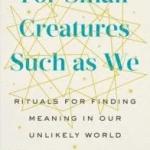 The year I graduated from high school (1971), my brother and I spent the summer traveling throughout the Western United States. Along the way, someone gave me a copy of The Upanishads, which I casually read as we traveled.
The year I graduated from high school (1971), my brother and I spent the summer traveling throughout the Western United States. Along the way, someone gave me a copy of The Upanishads, which I casually read as we traveled.
In Washington, somewhere between Mount Rainier and Yakima, while my brother drove, I dozed off. While sleeping, I had a vivid dream. In the dream I saw a golden ball on the horizon. As I gazed at it, golden strings grew out of the ball and where these strings landed on the ground, they formed into smaller golden balls, until the landscape was filled with these orbs. Then figures began to emerge inside the balls – people and animals dancing upon the land. After a time, these figures were reabsorbed back into the smaller balls which were then reabsorbed back into the large one. Eventually, they had all returned and the dream ended as it began, with just the golden ball.
At the time, and still today, I pay attention to my dreams. I wrote this dream down in a notebook. Years later, I was leafing through the notebook and re-read my description of this dream. It occurred to me then that in this dream I had envisioned one of the core messages of the Upanishads. My subconscious had understood aspects of the book I’d been reading in a way that only later I consciously came to understand it.
There are many Upanishads with varied views and approaches. But the ones that I had been reading all posited that the individual soul is identical with the divine ground of all existence. The essence of each individual is the divinity. Individual consciousness also exists, but individuality is contingent and ephemeral. In the dream, the divine is represented by the gold, individuality is represented by the figures that are dancing. The Chandogya Upanishad summarizes this idea in the statement tat tvan asi “thou art that. What we most truly are is the divine, the gold.
* * * * *
The word “mysticism,” like most of the terms for inner states, has many meanings and even more associations. For people who like logical and unambiguous ideas, mysticism is often used as a derogatory term, a synonym for fuzzy thinking or the occult. But for people who actually are mystics, and I consider myself one of them, there is nothing at all fuzzy or occult about the mysticism of ancient traditions such as the Upanishads or Taoism.
For us, mysticism is a systematic attempt to get at the very essence of being. As scholars seek knowledge, politicians seek power, or entrepreneurs seek riches, a mystic seeks the ultimate ground and fullness of Being. This “ultimate ground” is given many names — God, Tao, the Absolute, Nature, among them. But the experience of the mystic has universally been characterized by the same terms: it is characterized as a unity, or more accurately, a non-duality.
The experience of non-duality cannot be put into words. Words by their very nature contain a dualism between the symbol and the thing symbolized. But mystics being people, they try to express something of the experience in words. Many have expressed it as “the experience where subject and object are one and the same.” I believe there can be only one experience where subject and object are one and the same, and thus this experience is in a sense the one absolute experience possible for people.
In terms of the vision I had in Central Washington, it is the experience of being gold.
In a sense, this dream vision still captures the essence of my mysticism, which integrates living from the divine essence while still being a dancing individual. Over the years, though, I have found a way to translate this dream from the highly metaphysical terms of Eastern spirituality to the more down to earth concepts provided by a naturalistic viewpoint.
The Naturalism Interpretation
To the extent that the Naturalistic approach deals with it at all, “mind” is considered to be a phenomenon that takes place in and is caused by a neural system, particularly the brain. Since there are many individual brains, and no noticeable physical connection among these brains, the idea that all individual minds are in reality part of one universal mind would seem to be incompatible with a naturalistic world view. But digging a little deeper, I find there is a way to interpret this idea that is compatible with Naturalism.
Brains, in naturalism, are a kind of mechanism, made ultimately of matter. Naturalism does not allow for any kind of entity that is not in some sense material or at least physical. Information, for instance, is not in itself material, but is an organization of material and thus always resides in a material substrate. Thus a piece of music, which is a kind of information, can reside on vinyl, on plastic, or in a computer’s memory banks. The particular material is not important, what is important is that something of the organization that was originally notes on paper, is retained as the information is transformed from one material medium to another.
A writer on consciousness, emphasizing the mechanistic nature of the brain, made the statement that the brain secretes awareness like the liver secretes bile. I am not sure of the aptness of that analogy, but if we think of it in this way, we can see that though brains are multiple, the awareness that brains create should have somewhat the same characteristic in each brain. Just as one person’s bile and another’s have a similar chemical makeup, so one brain’s awareness is similar to another’s. Two people’s thoughts may be quite different, but the awareness that exists prior to and after the presence of any particular thought, is likely similar. And probably not terribly different from other animals with well developed brains.
So while the statement that all minds are one mind is not justified from a naturalistic position, the statement that all healthy human brains have essentially the same make up is. And, since from the naturalistic perspective the mind and its awareness is a result of the brain’s anatomy and physiology, it follows that all brains, and the minds generated by these brains, have essentially the same characteristics. Thus to experience what is most fundamental in one’s mind, as a conscious being, is also to experience something that is common to all.
As individuals we emphasize our differences. A mystical spirituality emphasizes our identicalness. Translating my vision from that summer long ago into naturalistic terms: as individuals, we each have our separate thoughts, feelings, desires, values, etc. dancing about; but in addition to being individuals, we are in essence the gold of awareness. Thou art that.













